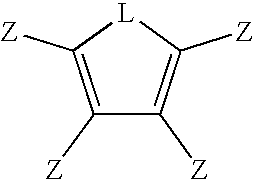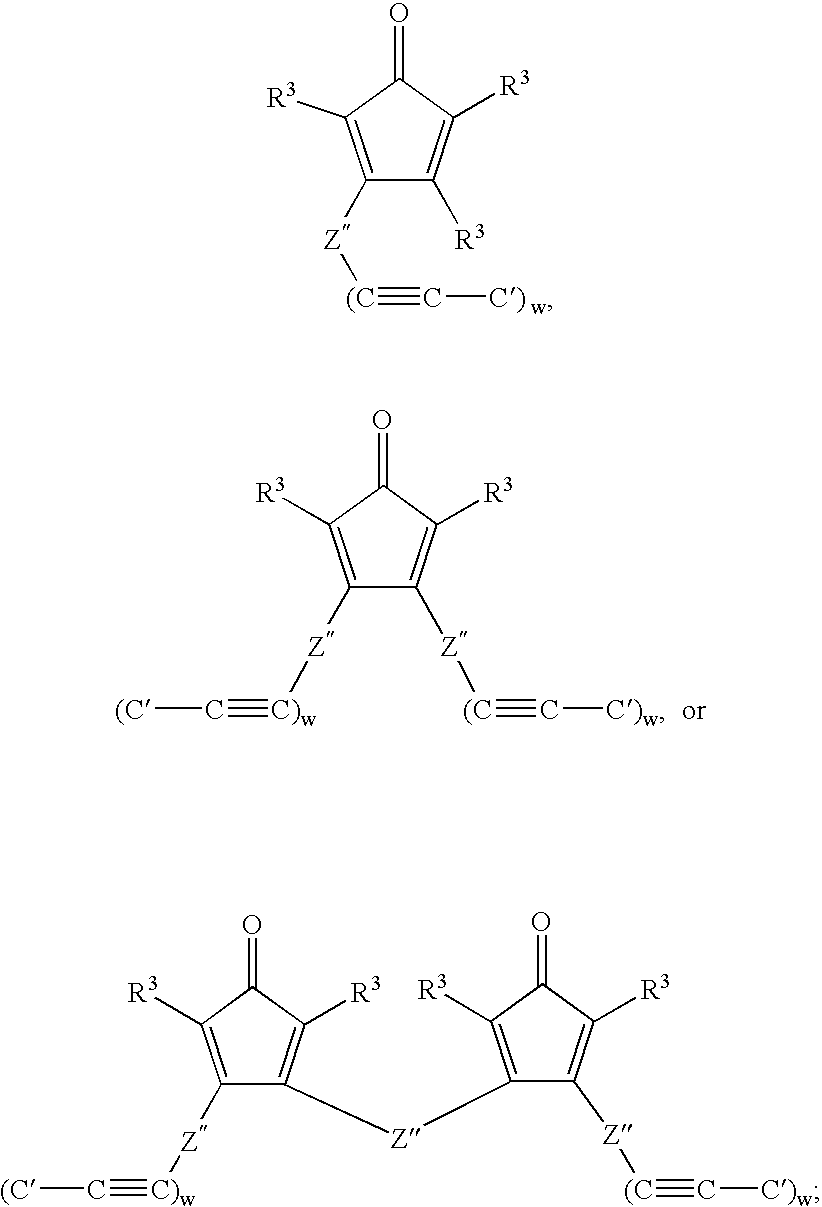Multifunctional menomers and polyarylene compsotions therefrom
- Summary
- Abstract
- Description
- Claims
- Application Information
AI Technical Summary
Benefits of technology
Problems solved by technology
Method used
Image
Examples
example 1
Synthesis of A2B2C′2 Monomer
[0090]
A) Synthesis of 4-Bromophenylacetyl Chloride
[0091] 4-Bromophenylacetic acid (99.5 grams, 0.46 mole) and N,N-dimethylformamide (2 milliliters) are added under a dry nitrogen atmosphere to a predried one liter glass single neck round bottom Schlenk reactor containing a predried magnetic stirring bar. After sealing under dry nitrogen, the reactor is placed on a Schlenk line under slightly positive nitrogen pressure. Thionyl chloride (300 milliliters) is added under a dry nitrogen atmosphere to a predried glass addition funnel which is outfitted with a Schlenk adaptor, then sealed under dry nitrogen and placed on the Schlenk line. The reactor and addition funnel are coupled under dynamic nitrogen flow, after which the thionyl chloride is added dropwise to the stirred reactor. Nitrogen flow is maintained into the Schlenk reactor, while gas from the reaction is vented through the Schlenk adaptor on the addition funnel and into a scrubber system. At the ...
example 2
Synthesis of A2BC′2 Monomer
[0097]
A) Synthesis of 4,4′-Benzocyclobuteneethynylbenzil
[0098] To a 100 ml round flask are added 4,4′-dibromobenzil (3.45. g, 0.0091 mole), DMF (20 ml), 3-benzocyclobutene-acetylene (2.56 g, 0.02 mole), and triethylamine (4 g, 0.04 mole). The resulting mixture is purged with nitrogen for 15 minutes, and then triphenylphosphine (0.08 g) and palladium acetate (0.017 g) are added. The reaction mixture is heated to 80° C. for 2 hours. After cooling down to room temperature, water (100 ml) is added. The crude product is filtered and the solid redissolved into methylene chloride. Upon evaporation of the solvent, yellow crystals are obtained which are further recrystallized from methylene chloride / hexanes.
[0099] Yield 3.2 g, 76 percent.
B) Monomer Synthesis
[0100] 4,4′-Benzocyclobutene-ethynyllbenzil (1.5 grams, 3.3 mmole) and 0.85 grams (4.1 mmole) of 1-(4-phenylethynylphenyl)-3-phenyl-2-propanone are added to a reactor containing 30 milliters of anhydrous 1-...
example 3
Synthesis of ABC′ Monomer
[0101]
A) Synthesis of Phenylacetyl 4-Bromophenyl Ether
[0102] To a stirred suspension of AlCl3 (62.5 g, 0.47 mole) in CH2Cl2 (130 ml) at 0° C. is added dropwise, a mixture of bromodiphenylether (92.7 g, 0.37 mole) and phenylacetic chloride (63.4 g, 0.41 mole) over a period of 60 minutes. After the addition is completed, the reaction mixture is stirred at 0° C. for another 4 hours and then slowly poured into 1 liter of ice / water. The resulting product is extracted with 800 ml of toluene and dried over Na2SO4. Upon evaporation of solvents, a yellow solid is obtained after recrystallization from 2-propanol.
[0103] Yield 122 g, 89 percent.
B) Synthesis of phenylacetyl-4-bromophenyl Ether
[0104] Phenylacetyl 4-Bromophenyl ether (66 grams, 0.18 mole) and dimethylsulfoxide (200 ml) are added to a two liter glass three neck round bottom reactor with magnetic stirring. Aqueous 48 percent hydrobromic acid (50 grams, 0.3 mole) is added with an addition funnel over thr...
PUM
 Login to View More
Login to View More Abstract
Description
Claims
Application Information
 Login to View More
Login to View More - R&D
- Intellectual Property
- Life Sciences
- Materials
- Tech Scout
- Unparalleled Data Quality
- Higher Quality Content
- 60% Fewer Hallucinations
Browse by: Latest US Patents, China's latest patents, Technical Efficacy Thesaurus, Application Domain, Technology Topic, Popular Technical Reports.
© 2025 PatSnap. All rights reserved.Legal|Privacy policy|Modern Slavery Act Transparency Statement|Sitemap|About US| Contact US: help@patsnap.com



